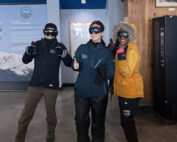You Call Those Mountains?!
2010-03-19 11:48:15.000 – Drew Hill, Summit Intern
I Love New Hampshire (and also NY)
I took a little jaunt over to the west coast this past weekend, visiting some friends and seeing the sights in Seattle. The Pacific Ocean? Awesome. Space Needle? Pointy. Public transportation… what is that? It was a fantastic visit, to say the least.
Now, I’m not sure if it’s their proximity to Canada or a gentleness that comes after spending 226 days a year draped in a dreary overcast, but Pacific Northwesterners are amazingly friendly. I often found myself discussing “the best fish & chips in Seattle” or “the tastiest mac-n-cheese on the planet” with random strangers– OK, get the food-jokes out of your system, because, yes, I like to eat (a lot). But, it never seemed to fail that every time the topic of “back-home” arose, this trite and seemingly-scathing question surfaced:
”You call those mountains?!”
I’ll admit, when Mt. Rainier finally peeked its head out of Seattle’s endless cloudveil on the fourth day of my visit, I was taken-aback. I spent the first three days assuming Rainier was just another indistinct peak hiding in the seemingly unimpressive Olympic Mountains across the bay. Boy was I mistaken; Rainier is a monster. Whether it was ostracized from its Cascade peers for its grotesque height or purposely chose to estrange itself from its (clearly) inferior compadres, Rainier stands alone. Dappled by speckles of sunlight sneaking through the broken clouds overhead, this behemoth was truly unlike anything I have ever seen on the east coast. But, I was not fooled. I know full well that these mountains are children– infants!– when compared with our wonderful Whites. They only really began to rise about 7 million years ago. Seriously Washington, your claim to fame only dates back to the Pliocene? Right, the Ring of Fire is pretty cool, but the Appalachians began their ascent to eminence over 480 million years ago. And let’s be honest, two continents crashing and smashing their way into each other is a pretty neat way to enter this world. To top it off, current geologic theory suggests that the wear and tear experienced since the peak (pun intended) of Appalachian height could have been enough to put Mt. Washington higher than any of the Himalaya!
So, yes, I call these mountains; please show some respect to your elders.
Well, I seem to have gone off on a bit of a rant. But to conclude on a less-than-bombastic note: I absolutely loved Seattle, and will surely be returning in the near future.
Drew Hill, Summit Intern
Team Flags Return for Seek the Peak’s 25th Anniversary
Team Flags Return for Seek the Peak's 25th Anniversary By MWOBS Staff Mount Washington Observatory is looking forward to continuing a much-loved tradition for Seek the Peak’s 25th Anniversary: Team flags. In inviting teams
Meet Summer Interns Zakiya, Max and Maddie
Meet Summer Interns Zakiya, Max and Maddie By MWOBS Staff We are excited to welcome six teammates to the summit of Mount Washington this summer! During their internship, these students and graduates will play
Saying Goodbye to the Summit
Saying Goodbye to the Summit By Alexis George After an extraordinary last three years working as a Weather Observer and Meteorologist, I am excited to pursue a different career. As sad I as am






